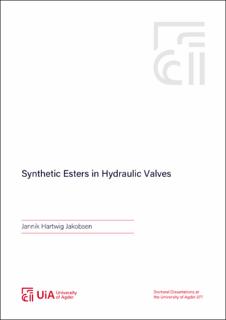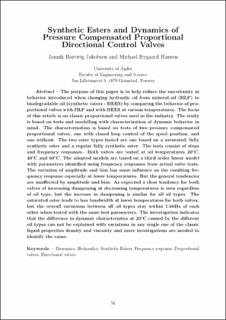| dc.contributor.advisor | Rygaard Hansen, Michael | |
| dc.contributor.advisor | Kofoed Nielsen, Henrik | |
| dc.contributor.author | Jakobsen, Jannik Hartwig | |
| dc.date.accessioned | 2020-05-27T21:09:34Z | |
| dc.date.available | 2020-05-27T21:09:34Z | |
| dc.date.created | 2020-05-18T16:27:53Z | |
| dc.date.issued | 2020 | |
| dc.identifier.citation | Jakobsen, J. H. (2020). Synthetic Esters in Hydraulic Valves (Doctoral thesis). University of Agder, Oslo. | en_US |
| dc.identifier.isbn | 978-82-7117-978-6 | |
| dc.identifier.issn | 1504-9272 | |
| dc.identifier.uri | https://hdl.handle.net/11250/2655838 | |
| dc.description.abstract | Each year 35-37 million tons of lubrication is consumed. Hydraulic oils constitute 10.2% of the total lubrication consumption, and a large part of that is lost to leakage, hose burst and accidents. One way of reducing the pollution caused by hydraulic oil lost in nature is to replace the standard mineral oil with an environmentally acceptable oil, EAL. EALs are already being used but to an extent, that is somewhat sector dependant, and reluctance amongst system designers is one of the factors limiting the usage. Hydraulic experts and end-users say, that two of the main obstacles are the lack of knowledge and the fear of technical problems.
The objective of this project is to map the current knowledge on EAL with a focus on synthetic esters, HEES, and build on the lesser-known topics. A state of the art on synthetic ester is made, which shows, the influence of HEES on several components is poorly covered by current research.
Two of the most commonly used valves in hydraulics is selected for studies: The pressure compensated directional control valve, PCPDCV, and the counterbalance valve, CBV.
The PCPDCV study focuses on characterizing dynamics valve response using frequency responses to fit linear models of 2nd and 3rd order. The CBV studies focus on describing the steady-state valve behaviour using CFD while identifying fluid dynamics and friction.
Experiments have been performed supporting the model work in the studies. Standard mineral oil with improved viscosity/temperature properties, HV, was used for reference, along with a partially saturated synthetic ester and a fully saturated synthetic ester. During experiments with the three oil types, valve behaviour with synthetic ester has been observed, included in the models and compared to the reference oil. Experiments were run at 20C-60C resulting in a benchmark targeting actual system design, where temperature, in general, cannot be assumed constant.
The changes in steady-state fluid dynamics, when comparing HEES to HV, were found to be insignificant by investigating steady-state CBV behaviour. The conclusion is based on estimates of the main discharge coefficient and the flow force found using CFD.
The steady-state friction identified differed significantly between both HEES and HV but also between saturated and partially saturated HEES oils. The strong link between hysteresis and friction in the CBV experiments allows for an evaluation of friction difference between oil types. The friction was up to 42% less for the fully saturated HEES and up to 20% higher for the partially saturated HEES. The friction of the CBV valve is known to be heavily influenced by its dynamic seals and it should be noted the seals were of the FPM type.
HEES was observed to have some influence on PCPDCV valve dynamics mainly at lower temperatures. The two PCPDCV valves investigated had different reactions to oil type. Almost no oil type dependency was observed for the open-loop controlled HAWE valve, while the closed-loop position-controlled Danfoss valve saw up to 28% reduction in bandwidth and an increase in the rise time of up to 18%. The reduction in bandwidth happened when using fully saturated HEES, but using partially saturated HEES resulted in a similar or faster valve. The reduction in bandwidth and increase in the rise time were most pronounced at low temperature (20C) and are less likely to be an issue at higher temperatures. | en_US |
| dc.language.iso | eng | en_US |
| dc.publisher | Wittusen & Jensen | en_US |
| dc.relation.ispartofseries | Doctoral Dissertation at the University of Agder; no. 277 | |
| dc.relation.haspart | Paper I: Jakobsen, J. H. & Hansen, M. R. (2018). Synthetic Esters and Dynamics of Pressure Compensated Proportional Directional Control Valves. In BATH/ASME 2018 Symposium on Fluid Power and Motion Control (68). doi: https://doi.org/10.1115/FPMC2018-8933. Author´s accepted manuscript. Full-text is available in AURA as a separate file: . | en_US |
| dc.relation.haspart | Paper II: Jakobsen, J. H. & Hansen, M. R. (Forthcoming). CFD Assisted Steady-State Modelling of Restrictive Counterbalance Valves. International Journal of Fluid Power. Author´s submitted manuscript. Full-text is not available in AURA as a separate file. | en_US |
| dc.relation.haspart | Paper III: Jakobsen, J. H. & Hansen, M. R. (Forthcoming). Steady-State Counterbalance Valve Modelling with the In uence of Synthetic Ester Oils Using CFD. Modeling, Identification and Control. Author´s submitted manuscript. Full-text is not available in AURA as a separate file. | en_US |
| dc.title | Synthetic Esters in Hydraulic Valves | en_US |
| dc.type | Doctoral thesis | en_US |
| dc.description.version | publishedVersion | en_US |
| dc.rights.holder | © 2020 Jannik Hartwig Jakobsen | en_US |
| dc.source.pagenumber | 156 | en_US |
| dc.source.issue | 277 | en_US |
| dc.identifier.cristin | 1811562 | |

